Site menu:
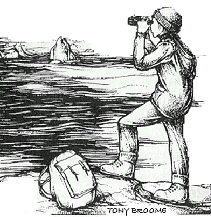
October 2008 Newsletter
Cheshire and Wirral Atlas.
September Bird News.
Forthcoming Events.
Latest Newsletter.
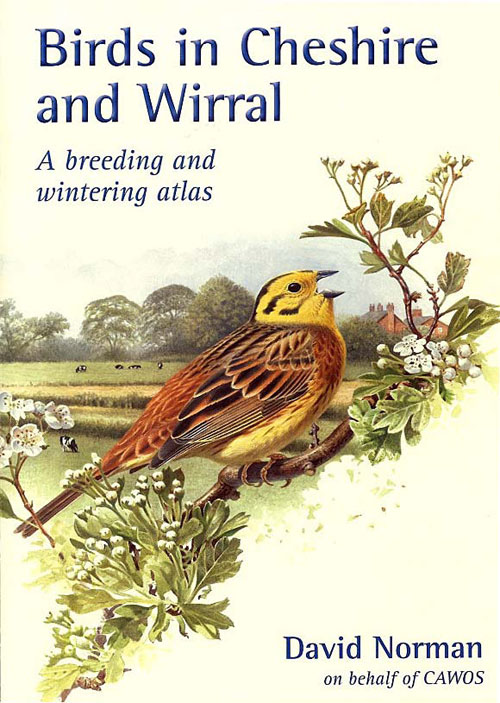
Many of you will have taken part in the survey work for the 2004-07 Cheshire and Wirral Breeding and Wintering Atlas. We can now look forward to its imminent publication as you can see from the publicity material below. I haven't seen any of the written material but I understand from those who have that it is going to be well worth the effort we have all put into it, not least, of course, the author David Norman. I'm sure many of you know David as an extremely knowledgeable local ornithologist; he is current Chairman of the Cheshire Wildlife Trust, CAWOS Council Member, RSPB Council Member and former acting Chairman of English Nature - and instigator of this whole Atlas project. He is more than well qualified to have written this landmark publication.
One of the most fascinating aspects of the Atlas is
going to be the comparison with the previous Breeding Bird Atlas for which
work was carried out between 1978 and 1984. For example, both Shelducks and
Oystercatchers, which used to breed mainly alongside the estuaries of the
Dee and Mersey, have now spread inland across much of the county. Climate
change has had a noticeable effect on breeding bird distribution with
Bearded Tits and Mediterranean Gulls now breeding, and the Hobby
increasing. The Atlas also shows dramatically the well known decline in
many farmland birds - for example the Corn Bunting has been lost from 223
tetrads, Tree Sparrow from 202. The Atlas shows the contrasting fortunes of
Buzzard and Cuckoo, Mute Swan and Starling, Barn Owl and Skylark. I can
hardly wait to get hold of a copy!
(The information for this paragraph was extracted from The Ups and Downs
of Cheshire's Birds by David Norman, published in the Autumn 2008
edition of The Grebe).
Richard Smith
For an order form to purchase the atlas at the pre-publication price of £30 click here.
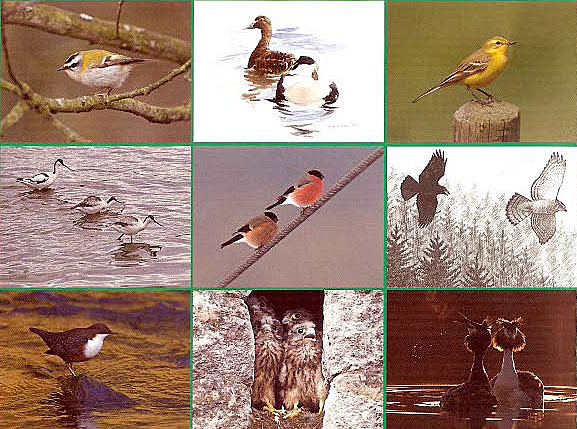

The Birds of Cheshire and Wirral: A Breeding and Wintering Atlas provides a richly-illustrated showcase of the birdlife of Cheshire and Wirral. The book details the results of a comprehensive survey, completed in 2007, of every bird species breeding in the county, and their distribution in winter. The result is a fascinating atlas with authoritative and highly readable text interspersed with illustrations by acclaimed local artists and photographers. The addition of 500 distribution maps makes this required reading for the keen ornithologist but The Birds of Cheshire and Wirral: A Breeding and Wintering Atlas will be a valuable book for anyone interested in the region's natural environment.
For an order form to purchase the atlas at the pre-publication price of £30 click here.

September Bird News
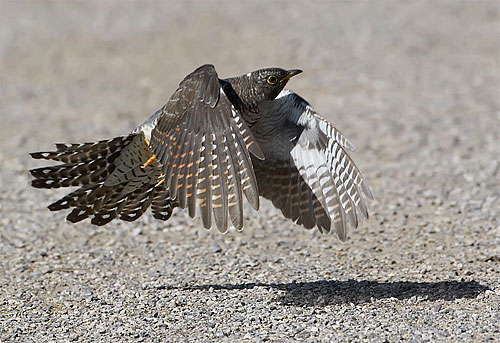
We had our own celebrity Cuckoo at Parkgate between 2nd and 18th - 'celebrity' because it was certainly a very well photographed bird, hanging around on the sea wall just north of the Old Baths Car Park. Sep 18th is late for a Cuckoo still to be here, in most years the last bird has left by late August.
September is usually a good month for seawatching, but this year either the wind was in the wrong direction, rather than the wished for north-westerlies, or virtually non-existent. We did get 235 Gannets past Hilbre on the 1st, 44 Manx Shearwaters at Red Rocks on 3rd and eight Arctic Skuas past Hilbre on the 8th - after that things became very quiet. But those calm conditions were ideal for counting the Great Crested Grebe flock off Hoylake and Meols - I had 214 on the 20th and 182 on the 27th, both counts almost certainly underestimates. Right at the end of the month the wind picked up again and we had 11 Leach's Petrel past Hilbre and a single at Red Rocks - hopefully October will bring more.
A White-winged Black Tern was a nice find over Shotwick Boating Lake, it was present from 5th to the 11th. A Black Tern was also there, with two on the 7th, together with a Black-necked Grebe. Other tern numbers dwindled rapidly through the month but there were still 700 Sandwich Tern around Hilbre on the 1st.
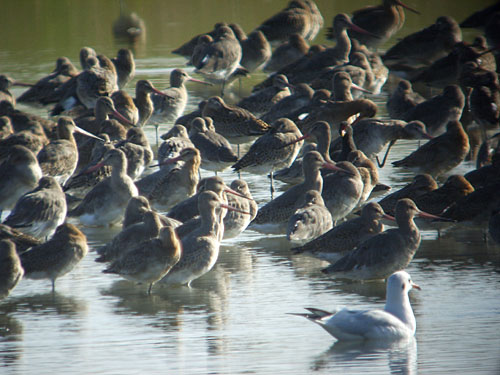
Black-tailed Godwit photo below by Charles Farnell, also at Gilroy NP.
Black-tailed Godwits came into roost at Gilroy Nature Park, West Kirby, all through the month - with max of 419. These gave great views as you can see from the photographs. they usually spent all day in the flooded field until about mid-afternoon when they would go to the estuary to feed. Up to 17 Shoveler, 2 Common Sandpiper, a Hobby, a Mediterranean Gull and good numbers of Snipe were also there. Large numbers of Black-tailed Godwits were further up the estuary with 3,000 seen from the Connah's Quay Reserve. Quite a few of these godwits are individually colour ringed and I'm planning another article on these in the near future.
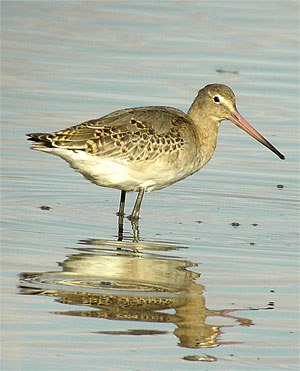 As
soon as the weather settled down we started getting a few Curlew Sandpipers
coming through.
Heswall again lived up to it's reputation as
the best site to see these delightful waders with four on the 13th, two the
next day and four still there on the 17th. Two were at the Point of
Ayr and three at Inner Marsh Farm over the
same period.
As
soon as the weather settled down we started getting a few Curlew Sandpipers
coming through.
Heswall again lived up to it's reputation as
the best site to see these delightful waders with four on the 13th, two the
next day and four still there on the 17th. Two were at the Point of
Ayr and three at Inner Marsh Farm over the
same period.
Other waders included a max of 15 Greenshank and 10 Spotted Redshank at the Connah's Quay Reserve
There have been a few Spoonbills around. One was still on the Oakenholt RSPB reserve until at least the 6th, probably the same bird was then observed at both Inner Marsh Farm and Parkgate on the 12th. On the last day of the month three turned up at Connah's Quay, possibly three of the five which had been on Crosby Beach on the 24th, see photo below!
There was a max of three Hen Harriers and one Marsh Harrier on the marshes, with a few sightings of Hobbies, Peregrines and Merlins. 14 Common Buzzards were in a field near the Harp Inn on the 20th. There have been several sightings of one or two Short-eared Owls, and the local Barn Owls seem to have had a good breeding season.
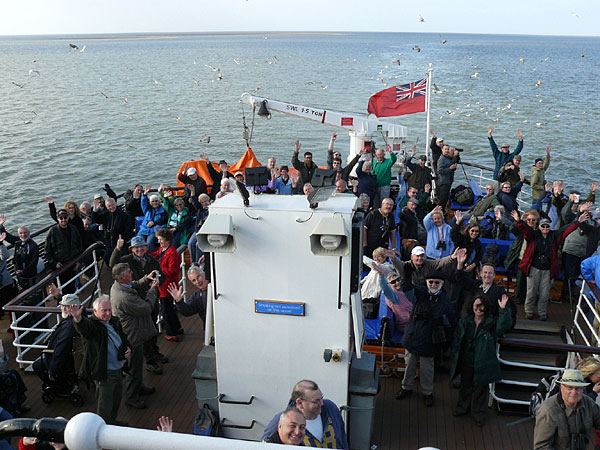
© Laura Bimson.
What to expect in October
Ideally we need a week of north-westerly gales at the beginning of the month followed by a period of winds from the easterly quadrant. The gales will bring in Leach's Petrels along with numerous other seabirds, whereas easterly winds should result in large numbers of finches and thrushes migrating south along the coast - and hopefully a few rarities turning up. Last year we had a Radde's Warbler and a Common Rosefinch - both firsts for Cheshire and Wirral, and a Blyth's Reed Warbler which is the second ever record for Cheshire and Wirral, although BBRC have pended this bird whilst seeking more information about this specie's plumage. That's apart from a Red-breasted Flycatcher, Yellow-browed Warblers, Great Grey Shrike etc.............!
For seawatching New Brighton has the reputation as being the best place in the whole country for seeing Leach's Petrels, but we need at least a full day of north-west gales to blow them in to the Mersey. Leasowe Gunsite, Leasowe Lighthouse, Red Rocks, Hilbre Island and Point of Ayr can also be excellent spots to see them fly past - often very close in.
For seeing visible migration the Wirral coast along the Dee Estuary can be very good, certainly Red Rocks on Oct 15th 2007 was amazing, but you need to be there early - the two hours immediately after dawn on a day when there is a gentle SE wind, a bit of mist but clear overhead is ideal.
Both duck and wader numbers should build up during the month. Expect to see about 10,000 Shelduck on the estuary with the majority off Thurstaston and Heswall. The first Brent Geese should arrive on Hilbre and on the marshes we should have both Marsh and Hen Harriers, plus Short-eared Owls. Unfortunately there are no really high spring tides forecast, at least during the day time - so don't expect the marsh at Parkgate to be covered. But I would certainly go to the Riverbank Road car park at Heswall where the marsh will be covered on the 15th, 16th and 17th.
Forthcoming Events
October Highest Spring Tides (Liverpool)
Also see
Tides page.
15th October, 12.13hrs (BST), 9.6m.
16th October, 12.51hrs (BST), 9.7m.
17th October, 13.32hrs (BST), 9.6m.
Forthcoming Events
Organised by the
Wirral Ranger Service ,
Flintshire Countryside Service and/or the RSPB:
All these events and walks have bird interest, even those not advertised
specifically for birdwatching. No need to book for these events unless
specified - please check below.
Sunday 19th October, 10am – 3pm, Connah’s Quay Reserve
Open Day.
Join the Deeside Naturalists Society for some spectacular
high-tide birdwatching. (HW: 29.5ft, 13.57). Location: From
A548 take the Connah’s Quay turn, and follow the Power
Station signs. A member of the society will greet you at the
reserve entrance. Further information: D.N.S. - 01244 537440.
Free.
Saturday 1st November
Free Guided Walk, Flint Saltmarsh, Meet at the Flint
Lifeboat stn Car park 10.30am.
Join RSPB warden for spectacular views of Black Tailed Godwit and other
birds. Wellingtons Advisable.
No need to book, further details call 0151 336 7681.
Saturday 15th November, 9.45am to Noon (high tide at 11.41am),
Kings Gap High Tide Birdwatch (Hoylake).
Come and join the RSPB, Wirral Rangers and
Voluntary Wardens watching the huge high tide wader roost at Kings Gap,
Hoylake. Expect to see thousands of Dunlin, Knot and Oystercatcher, and
hundreds of Grey Plover, Sanderling and Curlew - a magnificent sight!
Telescopes will be on hand for you to look at the birds, and experts will
be there to help you identify the birds. The Rangers and RSPB Wardens will be there from
9.30am, high tide is at 11.41am, so I would advise arriving an hour before
high tide so you can see the birds getting pushed in by the sea.
|
 |
The blank (UK) Birding Webring is a collection of quality birding web sites that are based in the United Kingdom. Visit the webring homepage for more information, or A complete list of all the sites in the webring is available by clicking here. previous site in ring : random site in ring : next site in ring |